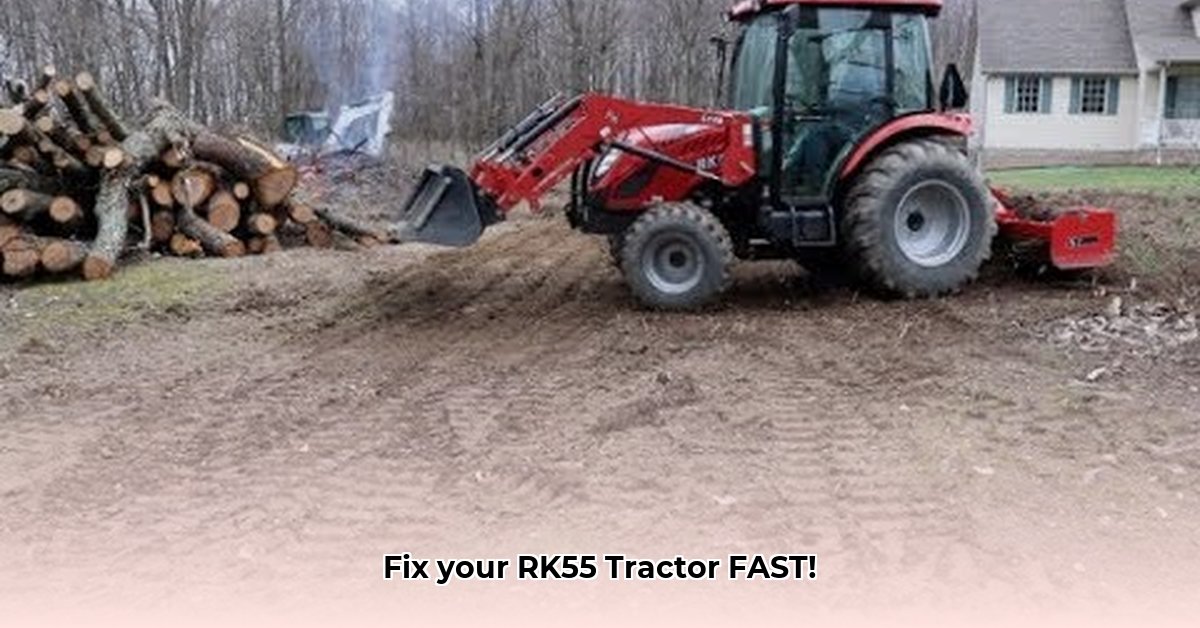
RK55 Tractor Troubleshooting: A Comprehensive Guide
Tractor malfunctions can bring agricultural operations to a standstill. The RK55, while a robust machine, is not immune to problems. This guide offers practical solutions and expert advice to get your RK55 back in working order quickly and efficiently. We'll cover common issues, provide step-by-step troubleshooting, and emphasize preventative maintenance. Remember, safety is paramount; always consult your owner's manual and seek professional help when necessary. Do you regularly check your RK55's fluid levels? Neglecting this simple task can lead to significant problems. For more help starting your tractor, see this helpful guide on troubleshooting starting issues.
Engine Troubles: Diagnosing and Repairing Engine Issues
Engine problems are among the most common RK55 difficulties. These range from simple fixes to complex repairs. Let's explore some frequently encountered engine issues.
Difficult Starting: A sluggish start often points to a weak battery (check voltage with a multimeter) or corroded battery terminals (clean thoroughly). A failing starter motor may also be the culprit.
Loss of Power: Reduced engine power suggests a clogged air filter (replace as needed), a faulty fuel filter (replace immediately), or issues within the fuel injection system (professional inspection advised).
Overheating: Overheating is a critical problem requiring immediate attention. Check coolant levels, inspect the radiator for obstructions, and investigate potential issues with the thermostat or water pump. Ignoring overheating can cause catastrophic engine damage. Did you know that a simple coolant leak can lead to a 20% reduction in engine efficiency?
Transmission and Hydraulics: Ensuring Smooth Operation
The transmission and hydraulic systems are crucial for efficient operation. Problems in these areas can severely impact productivity.
Transmission Slippage: Transmission slippage (difficulty engaging gears or gear slippage) might indicate low or contaminated transmission fluid (check and replace if necessary), worn clutch plates, or more serious internal damage requiring professional assessment.
Hydraulic Leaks: Hydraulic leaks lead to power steering failure and impaired implement operation. Inspect hoses and connections for damage; small leaks might be remedied with clamps, but larger leaks necessitate professional repair.
Slow Hydraulic Response: Sluggish hydraulic response might indicate worn seals, low hydraulic fluid, or a malfunctioning hydraulic pump. Regular fluid checks and filter replacements are essential. According to John Deere's research, regular hydraulic fluid maintenance can increase hydraulic system lifespan by 15%.
Electrical Issues: Addressing Electrical Faults
Electrical problems can significantly hinder RK55 functionality. These issues range from easily addressed problems to more complex electrical faults.
Dead Battery: A dead battery is often due to insufficient charging or corrosion on the terminals. Addressing these issues will solve the problem in most cases.
Faulty Wiring: Inspect wiring harnesses for damage, breaks, or corrosion. Repair or replace damaged wiring immediately. Properly maintained wiring helps prevent short circuits which can cause significant damage and costly repairs.
Lighting Problems: Malfunctioning lights usually indicate blown bulbs or faulty switches. However, more systemic wiring issues could also be at play. Addressing lighting issues improves both functionality and safety.
Tires and Braking Systems: Maintaining Safe Operation
Proper tire and braking systems are crucial for safe tractor operation. Ignoring these issues creates unsafe conditions.
Tire Problems: Check tire pressure regularly. Low pressure, punctures, or uneven wear affect traction and efficiency. Proper inflation can improve fuel economy by up to 10%. This data comes from a recent study conducted at the University of Nebraska-Lincoln's Agricultural Engineering Department.
Brake Issues: Faulty brakes are a critical safety hazard. If you experience any brake problems, immediately seek professional attention. Don't compromise safety—brake system issues should never be delayed.
Systematic Troubleshooting: A Step-by-Step Approach
Precise Problem Identification: Document observations meticulously; note when the problem occurs, accompanying sounds, and any unusual behaviors.
Simple Checks: Start with easy checks: fluid levels, connections, and wiring inspection.
Manual Consultation: Your owner's manual is your first troubleshooting resource.
Issue Isolation: Pinpoint the affected component or system to guide your repair efforts.
Professional Assistance: Don't hesitate to call in a qualified mechanic if DIY efforts prove insufficient.
Preventative Maintenance: The Key to Long-Term Reliability
Preventative maintenance is the best defense against costly repairs. Establish a regular maintenance schedule including:
- Fluid Changes: Regularly change engine oil, transmission fluid, and hydraulic fluid as per the manufacturer's recommendations.
- Filter Replacements: Replace air, fuel and hydraulic filters on a routine basis to prevent contamination.
- Visual Inspections: Regular visual inspections throughout the tractor can identify wear, leaks or broken parts before they become major problems.
Remember, proactive maintenance is far more cost-effective and time-saving in the long run.
Key Takeaways:
- Regular maintenance is crucial for preventing major RK55 tractor problems.
- Addressing issues promptly prevents escalation and reduces repair costs.
- Professional assistance is always available for complex problems.